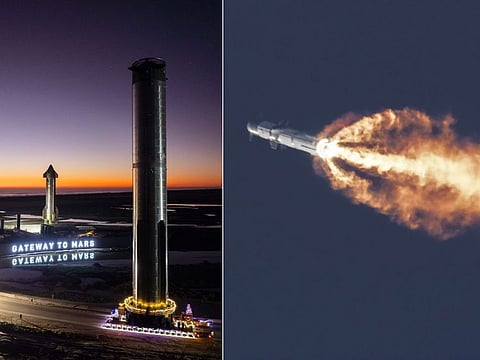Starship: How it will fly people to Mars?
Its ultimate mission: Make space exploration more accessible, affordable

When fully stacked, SpaceX's Starship stands taller than the Statue of Liberty, and packs more power than the Saturn V rocket, which took man to the Moon.
Now, humanity's hope for an exciting prospect of being multi-planetary rides on this powerful spacecraft. The upcoming test flight, already its fourth, is dubbed as a milestone in space exploration.
Starship Flight 4 is set for launch on Thursday (June 6, at the earliest) pending regulatory approval. It comes with numerous improvements from the previous flights.
What you need to know about this flight:
What is the Starship?
Starship is SpaceX’s two-stage rocket system designed to take humans back to the Moon and possibly, Mars.
The system consists of two stages: the “Super Heavy” booster and the Starship spacecraft itself. The booster provides the initial thrust needed to reach orbit, while the Starship spacecraft completes the journey.
Why is it significant?
Ultimately, the world’s most powerful rocket is designed to enable the return of humans to the Moon first, before going far beyond, and explore and colonise Mars and other destinations in the solar system.
If it succeeds in this demonstration flight, Starship becomes most powerful rocket systems ever developed, surpassing the size of the Saturn V rocket, developed by Nasa and used in the Apollo missions.
The core mission of SpaceX's Starship is to revolutionise space travel by making it more affordable and accessible. Designed for reusability, it aims to carry crew and cargo beyond low-earth orbit. It’s already contracted return humans to the Moon as part of Nasa’s Artemis programme.
When is the next test flight?
June 6, 2024. Regulatory approval is pending, as of June 3, 2024.
What are the major improvements on Flight 4?
According to Nasa Space Flight and, the Starlink Flight 4 improvements will test the following:
Enhanced propellant filtration: Improvements to prevent liquid oxygen filter blockages experienced in previous flights.
Additional roll control thrusters: Added to improve attitude control during re-entry.
Hot-staging adapter removal: This will reduce the booster’s mass and enhance landing control.
Landing techniques: Focus on controlled water landings to advance reusability goals.
Will it be fully reusable?
Both the Super Heavy booster and the Starship spacecraft are designed to be fully reusable – which is intended to significantly reduce the cost of space travel.
Where is it launched?
SpaceX conducts its Starship launches from its facilities in Boca Chica, Texas, also known as the “Starbase”.
What rocket engine and fuel does it use?
Starship is powered by “Raptor” engines, which use liquid methane and liquid oxygen (methalox) as propellants. This choice is partly to facilitate refueling on Mars, where methane can be synthesised from local resources.
The use of methalox propellants is considered more environmentally friendly compared to traditional rocket fuels, as they produce fewer pollutants and can be manufactured from renewable resources.
When will it really reach Mars and how?
Starship is designed for a variety of missions, including launching satellites, space tourism, lunar landings under Nasa’s Artemis programme (new US lunar exploration program), and eventually establishing human settlements on Mars.
Space X founder Elon Musk’s ultimate aim for the new vehicle is the occupation of Mars, and other solar system destinations.
There’s no date yet for its Mars mission. Musk, on many occasions, said he would like to die on Mars – “just no on impact”.
How did Space X change space launch economics?
Rocket development is expensive and time consuming. Starship is still experimental: the first three flights and previous tests involving prototypes failed — or were destroyed during test flights.
A rocket capable of delivering a spacecraft into orbit is an extremely large, complex, multi-stage device, subject to an extreme range of temperatures and burning highly corrosive and hazardous fuels. In addition to the engineering challenges, the major reason why space launch is expensive is because, in the past, a new vehicle must be built with every launch.
Not so with SpaceX's Falcon rockets, which has dramatically changed the launch cost equation, in addition to the visual treats of rockets landing back to earth or drone ships vertically.
The Falcon 9 rocket’s first stage (main booster), typically accounts for 60 per cent of the cost of the rocket itself. When recovered and reused multiple times, it brings the cost remarkably lower.
The same thing with recovering the second stage, about 20 per cent of the cost, and the fairings, which account for another 10 per cent. Launch-associated logistics typically account for the other 10 per cent.
While launch economics have changed, test operations are expensive. The tests and improvements in operations are extremely “iterative”, or constantly repeating itself, i.e. engineers repeatedly test their components, learn from failures and update their design until the engine is ready to go.
Yet adding rapid reusability has completely disrupted the space industry, allowing SpaceX to dominate launches, and sending its market cap to an estimated $200 billion as of end-May 2024.
Will Starship succeed?
Amid its failures (included numerous prototypes and test flights) are successes and innovations that demonstrated key technologies such as controlled landing, reusability and cost savings.
The iterations and development will eventually make space travel more affordable and routine, potentially opening commercial ventures and exploration of other planets, thus making humanity a space-faring civilisation.
STARSHIP: BY THE NUMBERS
OVERALL Height: 120 meters (394 feet) when fully stacked with the Super Heavy booster (vs 93 metres for Statue of Liberty) Diameter: 9 meters (30 feet) 'SUPER HEAVY' BOOSTER Height: Approximately 69 meters (226 feet) Diameter: 9 meters (30 feet) STARSHIP SPACECRAFT Height: Approximately 50 meters (164 feet) Diameter: 9 meters (30 feet) Payload Capacity: Up to 100 tons to low Earth orbit (LEO), Configurable for carrying up to 100 passengers for long-duration missions.
Sign up for the Daily Briefing
Get the latest news and updates straight to your inbox



